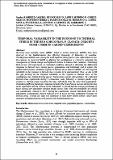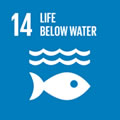Por favor, use este identificador para citar o enlazar a este item:
http://hdl.handle.net/10261/333496COMPARTIR / EXPORTAR:
 SHARE
BASE SHARE
BASE
|
|
| Visualizar otros formatos: MARC | Dublin Core | RDF | ORE | MODS | METS | DIDL | DATACITE | |

| Título: | Temporal variability in the response to thermal stress in the red gorgonian, P. clavata: Insights form common garden experiments |
Autor: | Ramírez Calero, Sandra Patricia; Bensoussan, Nathaniel CSIC ORCID; López-Sendino, P. CSIC ORCID ; Gómez-Gras, D. CSIC ORCID ; Montero-Serra, Ignasi CSIC ORCID CVN; Pagès-Escolà, Marta; Medrano, Alba; López-Sanz, Àngel CSIC ORCID; Figuerola, Laura; Linares, Cristina CSIC ORCID; Ledoux, J. B. CSIC ORCID; Garrabou, Joaquim CSIC ORCID | Palabras clave: | Marine heat-waves Octocorals Temporal series Population genetics Conservation |
Fecha de publicación: | 20-sep-2022 | Editor: | Unesco | Citación: | Proceedings of the 4th Mediterranean Symposium on the Conservation of Coralligenous & other Calcareous Bio-Concretions: 98-103 (2022) | Resumen: | Recurrent mass mortality events (MMEs) linked to marine heatwaves (MHWs) have been observed in the Mediterranean Sea affecting thousands of kilometers of coastline. Coralligenous habitats were among the most impacted during these events. Information on how the exposure to recurrent MHWs is affecting the coralligenous is critical to anticipate the consequences of climate change and implement actions to enhance their resilience. Combining field surveys with experiments in controlled conditions allowed to dilucidate the differential responses to thermal stress among species, populations and individuals and to explore the spatial and taxonomic variability response to thermal stress linked to MHWs. Yet, the temporal variability in the response to thermal stress remains to be characterized. Thus, we aim to fill this gap focusing on the temporal variability in the response to thermal stress of the coralligenous key habitat-forming species Paramuricea clavata (Plexauridae). We replicated thermal stress experiments during 3 consecutive years following a common garden setup (control vs. thermal stress) involving the same individuals from the same three populations. Considering different phenotypic responses including the level of tissue necrosis during the time of the experiment and the survival of the individuals, we found that the average percentage of tissue necrosis per population variated greatly across years while the probability of survival was considerably reduced in 2017. During the experiments, several individuals from the 3 populations systematically showed reduced level of tissue necrosis suggesting resistance to thermal stress. Overall our data will contribute to help better inform further conservation strategies of habitat-forming coral species in the Mediterranean Sea | Descripción: | 4th Mediterranean Symposium on the Conservation of Coralligenous & other Calcareous Bio-Concretions, 20-21 September 2022, Genoa, Italy.-- 6 pages, 2 figures | URI: | http://hdl.handle.net/10261/333496 |
| Aparece en las colecciones: | (ICM) Comunicaciones congresos |
Ficheros en este ítem:
| Fichero | Descripción | Tamaño | Formato | |
|---|---|---|---|---|
| Ramirez_Calero_et_al_2022.pdf | 318,34 kB | Adobe PDF |  Visualizar/Abrir |
CORE Recommender
NOTA: Los ítems de Digital.CSIC están protegidos por copyright, con todos los derechos reservados, a menos que se indique lo contrario.


